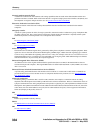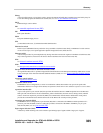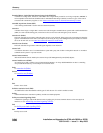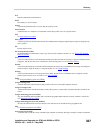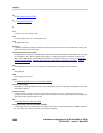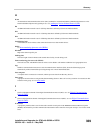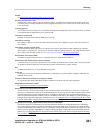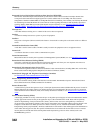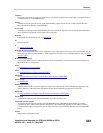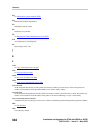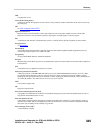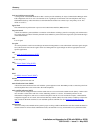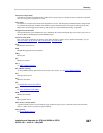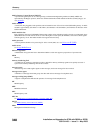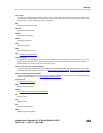
Glossary:
342
Installation and Upgrades for G700 with S8300 or S8700
555-234-100 — Issue 3 — May 2003
Integrated Services Digital Network Primary Rate Interface (ISDN-PRI)
The interface between multiple communications systems that in North America includes 24 64-kbps channels that
correspond to the North American digital signal level-1 (DS1) standard rate of 1.544 Mbps. The most common
arrangement of channels in ISDN-PRI is 23 64-kbps B-channels for transmitting voice and data, and 1 64-kbps D-channel
for transmitting associated B-channel call control and out-of-band signaling information. With nonfacility-associated
signaling (NFAS), ISDN-PRI can include 24 B-channels and no D-channel. See also
Integrated Services Digital
Network (ISDN); Integrated Services Digital Network Basic Rate Interface (ISDN-BRI).
intercept tone
A tone that indicates a dialing error or a denial of the service that was requested.
interface
A common boundary between two systems or pieces of equipment.
interflow
The process of using the Call Forward All Calls feature to forward calls to other splits on the same switch or a different
switch.
intermediate distribution frame (IDF)
A rack that is used to connect cables. An IDF is usually located in an equipment room or an equipment closet.
internal call
A connection between two users within a communications system.
internal measurements
Measurements that are made by the Avaya Basic Call Management System (BCMS). See also
external measurements.
International Direct Distance Dialing (IDDD)
The means to automatically dial international long distance telephone calls from your own telephone. Also known as
international direct dialing and international subscriber dialing.
International Telecommunications Union (ITU)
An international organization that sets universal standards for data communications, including ISDN. ITU was formerly
known as International Telegraph and Telephone Consultative Committee (CCITT).
International Telegraph and Telephone Consultative Committee
See
International Telecommunications Union (ITU).
Internet Engineering Task Force (IETF)
One of two technical working bodies of the Internet Activities Board. The IETF develops new Transmission Control
Protocol/Internet Protocol (TCP/IP) standards for the Internet.
Internet Protocol (IP)
A connectionless protocol that operates at layer 3 of the Open Systems Interconnect (OSI0 model. IP protocol is used for
Internet addressing and routing packets over multiple networks to a final destination. IP protocol works in conjunction
with Transmission Control Protocol (TCP), and is usually identified as TCP/IP. See also Transmission Control Protocol
(TCP).
Internet Protocol Security (IPSec)
A developing standard for security at the network layer or the packet processing layer of network communication. Earlier
security approaches inserted security at the application layer of the communications model. IPSec will be especially
useful for implementing virtual private networks (VPNs), and for remote user access through dial-up connection to
private networks. One advantage of IPSec is that security arrangements can be handled without requiring changes to the
computers of individual users. IPSec provides two choices of security service, Authentication Header (AH) and
Encapsulating Security Payload (ESP). AH allows authentication of the sender of data. ESP supports both authentication
of the sender and encryption of data. The specific information that is associated with each of these services is inserted
into the packet in a header that follows the IP packet header. Separate key protocols can be selected, such as the
ISAKMP/Oakley protocol.



